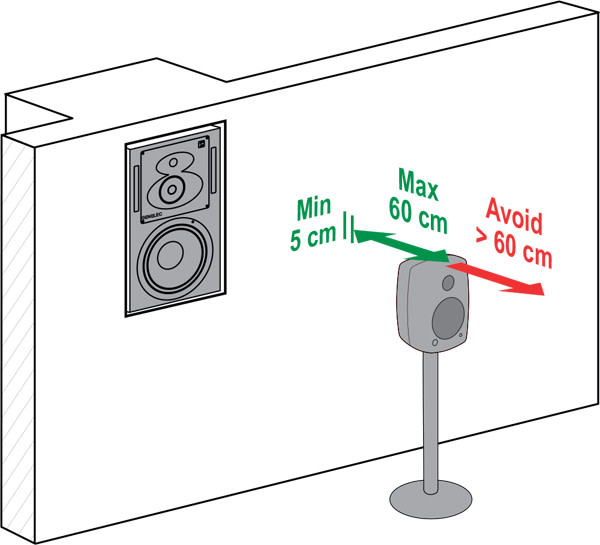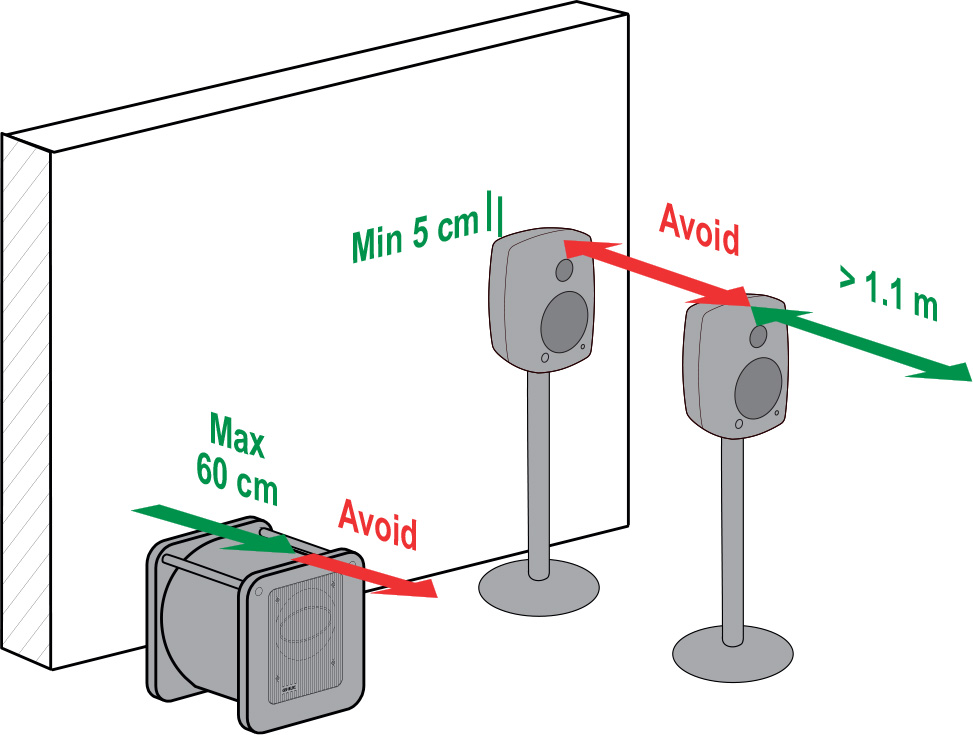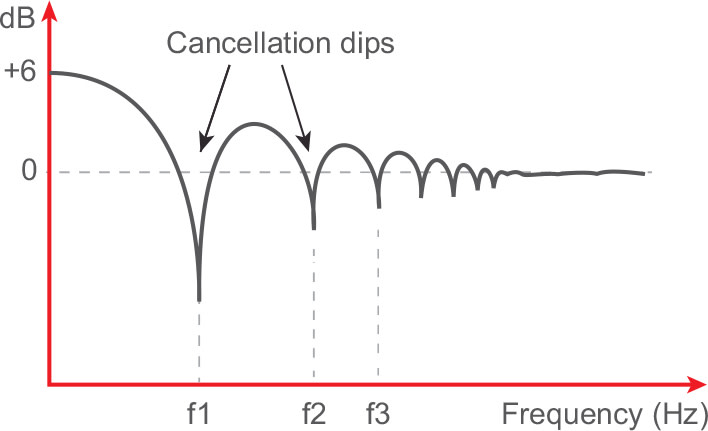Using AES. You are sufficiently driving the speaker if you can get them to go into protection. The limit is the amp/driver in that case.I read a user review somewhere that said using the AES input provided a significant boost to the SPL versus the analog input. Has anyone tried this?
-
WANTED: Happy members who like to discuss audio and other topics related to our interest. Desire to learn and share knowledge of science required. There are many reviews of audio hardware and expert members to help answer your questions. Click here to have your audio equipment measured for free!
You are using an out of date browser. It may not display this or other websites correctly.
You should upgrade or use an alternative browser.
You should upgrade or use an alternative browser.
Genelec 8341A SAM™ Studio Monitor Review
- Thread starter amirm
- Start date
Yet one must know that the 8341 is not sufficient for all domestic listening situations. Especially if you are building an end game system which means you will be treating your room.Agree it’s meaningless nitpicking, my intention at first was to wonder if at mid to far field if the 83x1 enough for loud SPL, the larger models exist for a reason. But anyway as someone sensitive to sound or loud sound, even concert level will drive me nuts so that’s irrelevant to me
Room treatments do take SPL from your listening position. It’s sort of the point.
If you are 100% sure you will only be using them near field then the 8331 and 8341 have their uses.
I have a friend who cannot listen past 9pm since his son will be in bed by that time. A pair of 8331s placed close by would be a good solution.
Pearljam5000
Master Contributor
- Joined
- Oct 12, 2020
- Messages
- 5,237
- Likes
- 5,477
It Seems only the 8361 and S360 won't clip easily
Even the 8351 is a compromise SPL wise
Even the 8351 is a compromise SPL wise
But same midrange driver though.It Seems only the 8361 and S360 won't clip easily
Even the 8351 is a compromise SPL wise
Out of interest, what do you listen to music on at the moment?It Seems only the 8361 and S360 won't clip easily
Even the 8351 is a compromise SPL wise
Pearljam5000
Master Contributor
- Joined
- Oct 12, 2020
- Messages
- 5,237
- Likes
- 5,477
It's pretty sad but i had the HD800, now i have the DT880 proOut of interest, what do you listen to music on at the moment?
So that's about it
Anyways I've found out i like speakers a lot More so that's my direction
I have 8050's and I've only been able to get the red lights on a couple timesIt Seems only the 8361 and S360 won't clip easily
Even the 8351 is a compromise SPL wise
I have 8050's and they play louder than I need. If I had the $$ for the 8351 or 61 I'd be i heaven.It Seems only the 8361 and S360 won't clip easily
Even the 8351 is a compromise SPL wise
PJ9k You know my untreated haphazard coffee table setup and I've never seen the amber or red LED's unless the 8341's are powered on with no AES signal (flashing red) or when updating firmware (solid amber) My ears give up to power compression and the room slap at 80-90dB SPL as measured with the GLM mic.It's pretty sad but i had the HD800, now i have the DT880 pro
So that's about it
Pearljam5000
Master Contributor
- Joined
- Oct 12, 2020
- Messages
- 5,237
- Likes
- 5,477
I have 8050's and I've only been able to get the red lights on a couple times
I have 8050's and they play louder than I need. If I had the $$ for the 8351 or 61 I'd be i heaven.
It's funny becausePJ9k You know my untreated haphazard coffee table setup and I've never seen the amber or red LED's unless the 8341's are powered on with no AES signal (flashing red) or when updating firmware (solid amber) My ears give up to power compression and the room slap at 80-90dB SPL as measured with the GLM mic.
Some say even the 8361, without subs don't have enough SPL
And others say 8030C can fill a small room
Honestly i don't know what to think anymore
I listen to a lot of prog and fusion. The 8050's I find go really loud. I do want to upgrade to SAM and add a sub but SPL for me is not an issue.It's funny because
Some say even the 8361, without subs don't have enough SPL
And others say 8030C can fill a small room
Honestly i don't know what to think anymore
My 6-way JBL stereo assemblage with 12 amp channels and BSS-BLU 160 is a locomotive that takes up a lot of space and only sounds better and better over 100 dB SPL, 108... My Gen's @ 80 are what I use everyday.
Canon EOS 5 D. Lens unspecified. https://commons.m.wikimedia.org/wiki/File:REC_STUDIO_GC.jpg#mw-jump-to-licenseOff topic but was that pic snapped with a cel tel or a devoted camera. Curious about the black levels.
I'm considering adding a sub to my current 8341 pair, and planning for the ideal placement. I came across the recommended monitor/sub placement from Genelec (https://www.genelec.com/monitor-placement#:~:text=Using a single subwoofer, a,the highest low frequency output).


The two plots are a bit hard to interpret. Is it saying, without a sub I should place monitors 5-60 cm from the wall, but when adding a sub, I need to put monitors at least 1.1m from the wall instead (while placing the sub within 60cm from the wall)?
If that's the case, it would be hard for my untreated home office desk setup. Any way I can get around the >1.1m requirement, like adding sound foam to the front wall or something?


The two plots are a bit hard to interpret. Is it saying, without a sub I should place monitors 5-60 cm from the wall, but when adding a sub, I need to put monitors at least 1.1m from the wall instead (while placing the sub within 60cm from the wall)?
If that's the case, it would be hard for my untreated home office desk setup. Any way I can get around the >1.1m requirement, like adding sound foam to the front wall or something?
dshreter
Addicted to Fun and Learning
- Joined
- Dec 31, 2019
- Messages
- 808
- Likes
- 1,258
The diagram is confusing, and even with a sub any of the “without sub” configurations are also acceptable. >1.1M into the room might be ideal, but <60cm should also be good just as it would be without a sub. Treatment at the first reflection behind the speaker will help mitigate the difference.I'm considering adding a sub to my current 8341 pair, and planning for the ideal placement. I came across the recommended monitor/sub placement from Genelec (https://www.genelec.com/monitor-placement#:~:text=Using a single subwoofer, a,the highest low frequency output).


The two plots are a bit hard to interpret. Is it saying, without a sub I should place monitors 5-60 cm from the wall, but when adding a sub, I need to put monitors at least 1.1m from the wall instead (while placing the sub within 60cm from the wall)?
If that's the case, it would be hard for my untreated home office desk setup. Any way I can get around the >1.1m requirement, like adding sound foam to the front wall or something?
The diagram is confusing, and even with a sub any of the “without sub” configurations are also acceptable. >1.1M into the room might be ideal, but <60cm should also be good just as it would be without a sub. Treatment at the first reflection behind the speaker will help mitigate the difference.
The second one is for bass management i.e. satellites-and-sub. The reason for the distances is because of quarter-wavelength cancellations. A distance of 1.1m is about 78Hz which is below Genelec’s default crossover point of 85Hz. 60cm is quarter wavelength of about 150Hz, well above the crossover point.I'm considering adding a sub to my current 8341 pair, and planning for the ideal placement. I came across the recommended monitor/sub placement from Genelec (https://www.genelec.com/monitor-placement#:~:text=Using a single subwoofer, a,the highest low frequency output).


The two plots are a bit hard to interpret. Is it saying, without a sub I should place monitors 5-60 cm from the wall, but when adding a sub, I need to put monitors at least 1.1m from the wall instead (while placing the sub within 60cm from the wall)?
If that's the case, it would be hard for my untreated home office desk setup. Any way I can get around the >1.1m requirement, like adding sound foam to the front wall or something?
For the image which includes an infinite baffle and a stand speaker, 5cm is Genelec’s recommendation for port clearance. But why they want to keep the null in the satellite above 150Hz, I don’t know. That one has confused me since I first saw it.
Regarding absorption, the closer to the wall, the easier it’ll be to minimize reflections because higher frequencies don’t require thick absorbers (short wavelength, high frequency). Another mitigation strategy is to ensure that the speaker is not equidistant to two or more boundaries which will reinforce the interference. The best practice is to deal with room-influenced SPL response with positioning but ultimately you have to make do with what you have available.
Last edited:
RobL
Addicted to Fun and Learning
- Joined
- Mar 4, 2021
- Messages
- 936
- Likes
- 1,563
….
For the image which includes an infinite baffle and a stand speaker, 5cm is Genelec’s recommendation for port clearance. But why they want to keep the null in the satellite above 150Hz, I don’t know. That one has confused me since I first saw it…
I think the idea is to move the null up to where the speaker begins to become directional, ie. less backward-directed component
Maybe but two things make me question that. 1. I don’t recall this reason being featured on the page whence this image originates and 2. the satellite speaker looks like a 8xx0 and their directivity doesn’t significantly narrow until about 450Hz. 60cm (~2’) is about 150Hz (‘s quarter wavelength). If they want it in the directional band, the gap needs to be no greater than just a few inches.I think the idea is to move the null up to where the speaker begins to become directional, ie. less backward-directed component
I post this link for directivity graphs of 8030.

Genelec 8030C Studio Monitor Review
This is a review and detailed measurements of the powered Genelec 8030C Professional Monitor (speaker). It is on kind loan from a member and costs US $700 each. The 8030C has the same look of Genelec speakers of the last decade or so: To me it looks more "cute" than serious piece of gear...
 www.audiosciencereview.com
www.audiosciencereview.com
Last edited:
RobL
Addicted to Fun and Learning
- Joined
- Mar 4, 2021
- Messages
- 936
- Likes
- 1,563
I remembered reading about this somewhere on Genelecs site…Found it here.Maybe but two things make me question that. 1. I don’t recall this reason being featured on the page whence this image originates and 2. the satellite speaker looks like a 8xx0 and their directivity doesn’t significantly narrow until about 450Hz. 60cm (~2’) is about 150Hz (‘s quarter wavelength). If they want it in the directional band, the gap needs to be no greater than just a few inches.
I post this link for directivity graphs of 8030.

Genelec 8030C Studio Monitor Review
This is a review and detailed measurements of the powered Genelec 8030C Professional Monitor (speaker). It is on kind loan from a member and costs US $700 each. The 8030C has the same look of Genelec speakers of the last decade or so: To me it looks more "cute" than serious piece of gear...www.audiosciencereview.com
Quoted:
“Wall reflections or back reflections generate a set of cancellations at different frequencies (also called comb filtering). The first cancellation notch can be between 6 dB and 20 dB deep. Equalization of the monitor output level does not help, as the same level change applies also to the reflected sound.

The first solution is to flush mount the monitors into a hard wall (creating a very large baffle) eliminating the rear wall reflections and therefore cancellations. Another possibility is to place the monitor very close to the wall minimising the gap. This raises the lowest cancellation frequency so high that the monitor has become forward-directing, and the cancellation no longer occurs.”
Yes, “very close” must mean within a few inches. I mean, we have exact spinorama data to know what frequency the monitors become directional.I remembered reading about this somewhere on Genelecs site…Found it here.
Quoted:
“Wall reflections or back reflections generate a set of cancellations at different frequencies (also called comb filtering). The first cancellation notch can be between 6 dB and 20 dB deep. Equalization of the monitor output level does not help, as the same level change applies also to the reflected sound.

The first solution is to flush mount the monitors into a hard wall (creating a very large baffle) eliminating the rear wall reflections and therefore cancellations. Another possibility is to place the monitor very close to the wall minimising the gap. This raises the lowest cancellation frequency so high that the monitor has become forward-directing, and the cancellation no longer occurs.”
The text which accompanies the ‘infinite baffle’ image is further down. All I interpret from it is that nulls above 150Hz are somehow less than those below. You can see that in the red and green SPL graphic right below. Perhaps it is due to higher modal density. Of course, if the first cancellation is low then subsequent cancellations will be higher and less severe. The question here, though, is why did they pick 60cm/150Hz when that’s below the directional band?
What I do think is true is that having both the flush- and stand-mounted speakers together means that both are full-range and not bass managed. Also, they do mention absorption and we already know that higher frequencies are more readily absorbed with reasonably thick materials. I know in my old room, 20 4” rigid panels and some fluffy 32”-wide superchunks with air gaps basically gave me zero decay time above 150Hz.
I’m not going to say their reasoning is not directivity related but their logic is not fully fleshed out on that page. Even so, it’s not essential that they spell it all out because the fundamental point is made: placement in a room will result in cancellations and our job is to balance that fact with the (frequency and directivity) response of the monitors we use.
Last edited:
Similar threads
- Poll
- Replies
- 237
- Views
- 40K
D
- Replies
- 34
- Views
- 4K
- Replies
- 331
- Views
- 45K
- Replies
- 3
- Views
- 503
